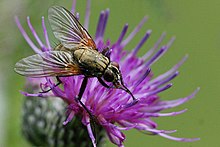| Helina | |
|---|---|
 | |
| Helina reversio | |
| Scientific classification | |
| Domain: | Eukaryota |
| Kingdom: | Animalia |
| Phylum: | Arthropoda |
| Class: | Insecta |
| Order: | Diptera |
| Family: | Muscidae |
| Subfamily: | Phaoniinae |
| Tribe: | Phaoniini |
| Genus: | Helina Robineau-Desvoidy, 1830 |
| Type species | |
| Anthomyia euphemioidea Robineau-Desvoidy, 1830 [1] | |
| Synonyms | |
| |
Helina is a very large genus from the fly family Muscidae. [2] [3]
Fungal species Strongwellsea selandia and Strongwellsea gefion from (genus Strongwellsea , order Entomophthorales) infects adult flies from genus Helina in Denmark. [4]